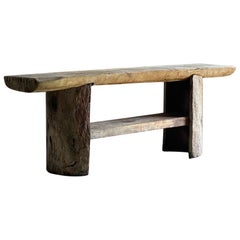Zanini de Zanine On Sale
Recent Sales
Vintage 1970s Brazilian Rustic Console Tables
Reclaimed Wood
A Close Look at rustic Furniture
For some, the phrase “rustic style” suggests a house like “La Pitchoune,” the late chef Julia Child’s cottage in Provence, with its exposed wooden beams and well-worn antique furniture. For others, rustic furnishings and decor prompt images of a place like the Lake Placid Lodge in Upstate New York, with its stone fireplaces and knotty pine paneling. Indeed, rustic furniture design takes many forms: twig furniture, a plank trestle table, a hand-stitched quilt, a chandelier made of deer antlers.
The rustic style originated in the late 1800s in England, where it was heavily influenced by Romanticism. By the 20th century, it had spread to the United States, adopted by wealthy New Yorkers and the National Park Service alike. Although there are many categories of rustic furniture, one of the most popular and familiar manifestations of the style is the 1903 Thomas Lee Adirondack chair.
Rustic design is perhaps mostly about texture and humble materials: hand-hewn wood, woven rush seating, wrought iron, coarse stone and weathered metal. As a decor, it exudes warmth and honesty, while a single piece of countrified design adds an intriguing visual counterpoint in a sleek, modern environment.
Easily identifiable by its rough textures, earthy colors and natural materials, rustic furniture helps bring the beauty of the outdoors inside. As you can see on 1stDibs, rustic wares offer no end of inspiration.
On the Origins of brazilian
More often than not, vintage mid-century Brazilian furniture designs, with their gleaming wood, soft leathers and inviting shapes, share a sensuous, unique quality that distinguishes them from the more rectilinear output of American and Scandinavian makers of the same era.
Commencing in the 1940s and '50s, a group of architects and designers transformed the local cultural landscape in Brazil, merging the modernist vernacular popular in Europe and the United States with the South American country's traditional techniques and indigenous materials.
Key mid-century influencers on Brazilian furniture design include natives Oscar Niemeyer, Sergio Rodrigues and José Zanine Caldas as well as such European immigrants as Joaquim Tenreiro, Jean Gillon and Jorge Zalszupin. These creators frequently collaborated; for instance, Niemeyer, an internationally acclaimed architect, commissioned many of them to furnish his residential and institutional buildings.
The popularity of Brazilian modern furniture has made household names of these designers and other greats. Their particular brand of modernism is characterized by an émigré point of view (some were Lithuanian, German, Polish, Ukrainian, Portuguese, and Italian), a preference for highly figured indigenous Brazilian woods, a reverence for nature as an inspiration and an atelier or small-production mentality.
Hallmarks of Brazilian mid-century design include smooth, sculptural forms and the use of native woods like rosewood, jacaranda and pequi. The work of designers today exhibits many of the same qualities, though with a marked interest in exploring new materials (witness the Campana Brothers' stuffed-animal chairs) and an emphasis on looking inward rather than to other countries for inspiration.
Find a collection of vintage Brazilian furniture on 1stDibs that includes chairs, sofas, tables and more.
Finding the Right console-tables for You
Few pieces of furniture are celebrated for their functionality as much as their decorative attributes in the way that console tables are. While these furnishings are not as common in today’s interiors as their coffee-table and side-table counterparts, console tables are stylish home accents and have become more prevalent over the years.
The popularity of wood console tables took shape during the 17th and 18th centuries in French and Italian culture, and were exclusively featured in the palatial homes of the upper class. The era’s outwardly sculptural examples of these small structures were paired with mirrors or matching stools and had tabletops of marble. They were most often half-moon-shaped and stood on two scrolled giltwood legs, and because they weren’t wholly supported on their two legs rather than the traditional four, their flat-backed supports were intended to hug the wall behind them and were commonly joined by an ornate stretcher. The legs were affixed or bolted to the wall with architectural brackets called console brackets — hence, the name we know them by today — which gave the impression that they were freestanding furnishings. While console tables introduced a dose of drama in the foyer of any given aristocrat — an embodiment of Rococo-style furniture — the table actually occupied minimal floor space (an attractive feature in home furniture). As demand grew and console tables made their way to other countries, they gained recognition as versatile additions to any home.
Contemporary console tables comprise many different materials and are characterized today by varying shapes and design styles. It is typical to find them made of marble, walnut or oak and metal. While modern console tables commonly feature four legs, you can still find the two-legged variety, which is ideal for nestling behind the sofa. A narrow console table is a practical option if you need to save space — having outgrown their origins as purely ornamental, today’s console tables are home to treasured decorative objects, help fill empty foyers and, outfitted with drawers or a shelf, can provide a modest amount of storage as needed.
The rich collection of antique, new and vintage console tables on 1stDibs includes everything from 19th-century gems designed in the Empire style to unique rattan pieces and more.
